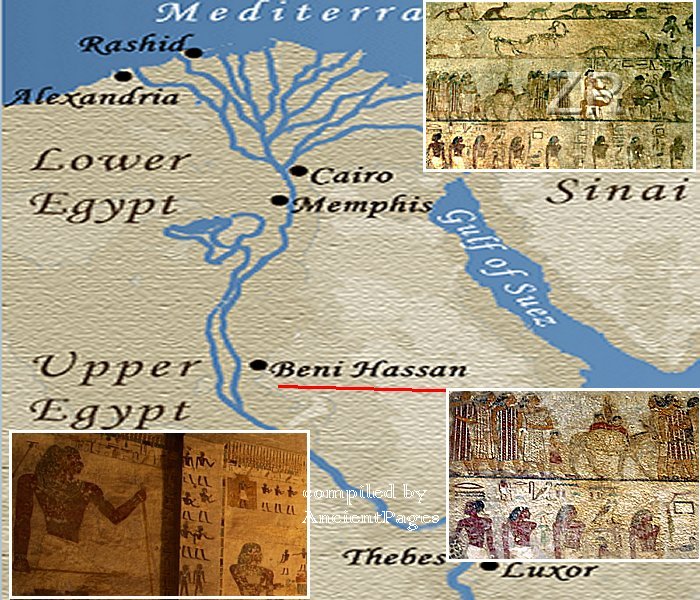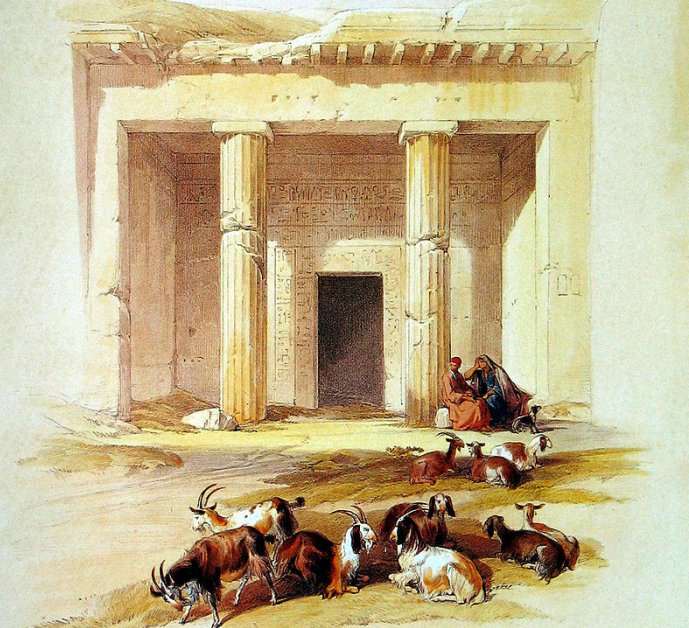A. Sutherland - AncientPages.com - The rock-cut tombs of an ancient Egyptian cemetery, Beni Hasan, were mainly used during the Middle Kingdom, from 21st to 17th century BC.
Entrance to a Tomb at Beni Hassan, David Roberts, 1838. Image credit: David Roberts - Public domain
They were constructed for many powerful nobles and provincial governors of the 11th and 12th dynasties (2125-1795 BC). During the reign of Sesostris III, many local workers decorated them, but later, when Sesostris III's power was reduced mainly, this burial tradition ceased.
There are 39 tombs carved into the limestone hillside south of the modern town of Minya on the east side of the Nile in Middle Egypt. Many have rich interior paintings depicting scenes from everyday life: most of them were robbed many times in antiquity.
However, the well-preserved wall decoration remained untouched until Percy Newberry, British Egyptologist, began meticulously recording every scene on the walls in 1890.

Ten years later, English archaeologist, John Garstang (1876 - 1956), came to Beni Hasan. During his two-year-long work, he unearthed and investigated almost nine hundred vertically-cut shaft tombs belonging to ordinary people who served the nobles.
Of all 39, only four of the tombs (those of Baqet III, Khety, Khnumhotep III, and Amenemhat) are available for visitors. The most impressive of them is that of Khnumhotep III, with a scene depicting the arrival of Asian visitors to Egypt.
Representation of Khety in his tomb (tomb 17). Image credit: - CC BY-SA 3.0
The tombs have columned entrances and the walls painted in horizontal registers that run around them. There are scenes with the provision of food, gathering papyrus, fishing and hunting, spinning and weaving, but simple local workers and not artists made the decorations. The figures have long, stick-like limbs that are disproportionate in size, all painted in grey, pink and orange colors.
The ownership of the tombs was recorded on the painted wooden coffins, which contained several burials, perhaps the entire families). The coffins were inscribed with a prayer to Anubis or Osiris and decorated with a pair of eyes. Through the eyes, the deceased could see.
Spells painted on the coffins' inside guaranteed the deceased's passage to the afterlife, and a 'map' to the underworld on the coffin's floor guided the soul on its journey.
Beni Hasan model funerary boat with crew. Image credit: Voluremuseum - CC BY-SA 4.0
Many of the bodies were badly mummified and wrapped quickly in bandages. No investigation confirmed whether the bodies were buried at the same time or added in different periods.
The most curious feature of the tombs was the colorfully painted tiny, wooden models found in every chamber and depicting miniature figures working in granaries, bakeries, different shops, workshops of carpenters, goldsmiths, and other artisans and industries.
Archaeologists also discovered model boats with tiny figurines of wooden sailors and miniature human figures (no more than 15cm (6in) tall and about 7.5cm (3in) in the tombs of the governors. They symbolized 'continuously work' for the deceased in the afterlife.
The most beautiful is the grave of Khnumhotep III, an Ancient Egyptian high steward and vizier of the 12th Dynasty. The tomb's walls are covered with lively and colorful scenes with many themes and Khnumhotep's well-preserved biographical inscription.
Written by – A. Sutherland AncientPages.com Staff Writer
Updated on August 2, 2022
Copyright © AncientPages.com All rights reserved. This material may not be published, broadcast, rewritten or redistributed in whole or part without the express written permission of AncientPages.com
Expand for referencesReferences:
I. Rosellini, F.Serino, The Monuments of Egypt and Nubia
Hobson Ch. Exploring the World of the Pharaohs
Spara
Spara
Spara
Spara
Spara






